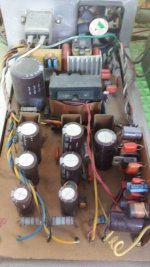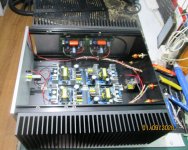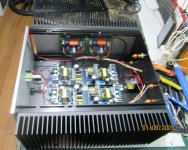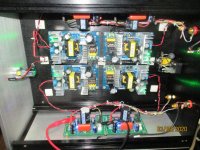Hi! I tried to feed Pass F5 with idle at 2 A with two Meanwell LRS-150-24 (23-27 V, 5 A) pch with the original 2 x 47,000 uF capacitor bank left. It worked well with no load, just the capacitors,. The voltage was stable at 26 V and i tried plenty of starts without any problems. But with the amplifier the SMPS constantly starts and stops (excuse the pun...) as if it was overloaded. I will put out the capacitors as a next try (but I really want it there, for the current capability), but does anyone know what's going on or what to do?
The Meanwell RSP series has current limit overload protection instead of hiccup mode.
So it will recover automatically without switching off completely.
And I agree that most SMPS do not like extra caps at the output.
You should consult the manufacturer beforehand.
Patrick
So it will recover automatically without switching off completely.
And I agree that most SMPS do not like extra caps at the output.
You should consult the manufacturer beforehand.
Patrick
The output capacitor value, in Farad and its ESR; and the load resistance all toguether enter in consideration in the transfer function at closed loop. Clearly 0.1F doesn't enter in any sane brain to design this kind of SMPS's.
Agaon, use 100uF for local high frequency audio decoupling.
Agaon, use 100uF for local high frequency audio decoupling.
OK. The usual thing, don't try to combine the two worlds, linear and switching.... Thanks.
BTW, I asked Meanwell but got a standard answer, not explicite in what will happen--and, as I wrote, without load they seem to behave.
BTW, I asked Meanwell but got a standard answer, not explicite in what will happen--and, as I wrote, without load they seem to behave.
It is true that this is Class AB and not Class A :
https://www.diyaudio.com/community/...4ohm-amplifier-with-smps.386169/#post-7020099
Patrick
https://www.diyaudio.com/community/...4ohm-amplifier-with-smps.386169/#post-7020099
Patrick
The F5 and its variants get unstable if the power supply is not capable of delivering current quickly.
At least my experience using linear PSUs.
Maybe not 47000µF, but also not 100µF either.
Patrick
At least my experience using linear PSUs.
Maybe not 47000µF, but also not 100µF either.
Patrick
The F5 and its variants get unstable if the power supply is not capable of delivering current quickly.
At least my experience using linear PSUs.
Maybe not 47000µF, but also not 100µF either.
Patrick
the rule of thumb for me is to get an smps with current delivery capability of 4 or more times that the load actually use....more if you can afford it..
Tony Tecson: The large capacitance was a leftover from the linear PSU so I just used it. And the SMPS:s didn't complain, with no load so I went on.
4 times 1.5 A ... Then 5 A should be OK.
Now I have tested with 220 uF and the SMPS shuts down anyway. Maybe the linear PSU i the ****... Less nervous.
4 times 1.5 A ... Then 5 A should be OK.
Now I have tested with 220 uF and the SMPS shuts down anyway. Maybe the linear PSU i the ****... Less nervous.
Charge the caps to nominal voltage. Disconnect caps. Connect amp to amps - power on. Now, by a switch on the plus side, add the caps. Not ideal but may work and you can find out if you are missing anything... 🙂
//
//
I spent a few months playing with Meanwell SMPS in various applications. I also compared them extensively with liner power supplies (powering up the various streamers and Aleph J). They do not need external capacitors bank. The phase distortion/margin will be screwed entirely if you start to add wiring and capacitors. They already have oversized capacitor banks on the PCB. You just need to tell your brain/mindset to let go.
The only thing they need is to replace the solid aluminium links/bars with copper ones.
When you look at the AP measured performance, there is no difference between SMPS and the liner power supply... except for the noise that SMPS spit back into mains supply.
However, subjectively... I could not get the natural, extended frequency range from any SMPS I tried... compared to a linear power supply. And I tried hard (and I spent a lot of time and money). They also spit a lot of rubbish back into the mains, which is easily overlooked... but very important to prevent. I could also not achieve any perception of depth in a soundscape, with SMPS. This was puzzling and very frustrating. I could get the right harmonic spectrum, but that was all.
The SMPS that arrived with my NUC performed by far the best sound-wise; much better than any MeanWell I tried.
I did the above as an overture into possibly delving into high-end class D amplification... Well, this ain't gonna be happening after my experience with SMPS.
The only thing they need is to replace the solid aluminium links/bars with copper ones.
When you look at the AP measured performance, there is no difference between SMPS and the liner power supply... except for the noise that SMPS spit back into mains supply.
However, subjectively... I could not get the natural, extended frequency range from any SMPS I tried... compared to a linear power supply. And I tried hard (and I spent a lot of time and money). They also spit a lot of rubbish back into the mains, which is easily overlooked... but very important to prevent. I could also not achieve any perception of depth in a soundscape, with SMPS. This was puzzling and very frustrating. I could get the right harmonic spectrum, but that was all.
The SMPS that arrived with my NUC performed by far the best sound-wise; much better than any MeanWell I tried.
I did the above as an overture into possibly delving into high-end class D amplification... Well, this ain't gonna be happening after my experience with SMPS.
The output capacitor value, in Farad and its ESR; and the load resistance all toguether enter in consideration in the transfer function at closed loop. Clearly 0.1F doesn't enter in any sane brain to design this kind of SMPS's.
Agaon, use 100uF for local high frequency audio decoupling.
For audio applications, the magic number is 1uF.
the thing i look out for in an smps is current delivery, not so much about filter caps values, available units come with paralleled 2200/50vdc at the output, for example in my 48v ACA amp which called for 1.4A supply current, i chose an smps brick that can deliver 4A..
Attachments
I have built an F5 with a pair of the same MeanWell LRS-150-24 that you used, and a LC SMPS filter designed my Mark Johnson.
Worked perfectly.
Huge amount of capacitance downstream of a SMPS seems to be very problematic. I’d try maybe 2000-3000uF as @EUVL suggests.
Worked perfectly.
Huge amount of capacitance downstream of a SMPS seems to be very problematic. I’d try maybe 2000-3000uF as @EUVL suggests.
- Home
- Amplifiers
- Power Supplies
- SMPS in F5 class A amp failure




